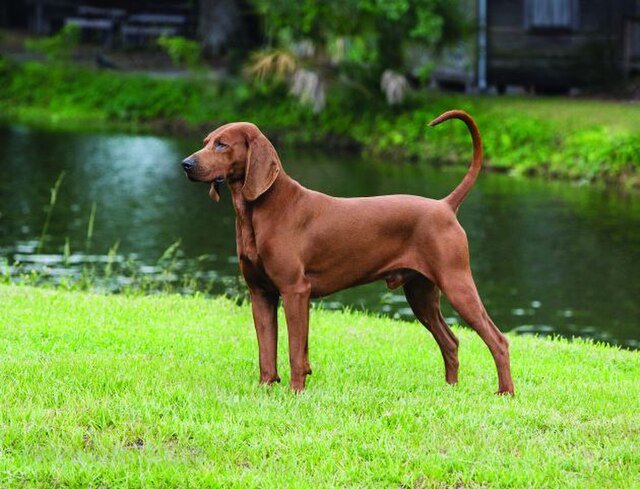


The Redbone Coonhound is a medium-sized, versatile hunting dog known for its stamina, agility, and determination. As one of the many coonhound breeds, the Redbone is particularly skilled at tracking and treeing raccoons and other small game. They are best known for their sleek red coat, long ears, and expressive eyes. Although originally bred for hunting, the Redbone Coonhound has also gained popularity as a family companion due to its friendly and loyal nature. These dogs are known for their strong noses, tracking abilities, and excellent sense of smell, which makes them prized in both hunting and search-and-rescue work. They are active, intelligent, and affectionate dogs that do well in active households.
The Redbone Coonhound was developed in the United States in the 19th century, primarily for hunting purposes. Its ancestors are thought to include a mix of English Foxhounds, Irish Hounds, and other coonhound breeds. The Redbone was bred to be a dedicated tracker and treeing dog, capable of locating raccoons, opossums, and other small game, even in dense forests. Over time, the Redbone Coonhound became well-regarded in the southern U.S., particularly among hunters in states like Tennessee and Alabama. Its name comes from its distinctive red coat color. Though originally bred for hunting, the Redbone Coonhound has become a popular companion animal in recent years due to its friendly disposition and adaptability to family life. The breed was officially recognized by the American Kennel Club (AKC) in 2009.
The Redbone Coonhound is a well-built, medium-sized dog with a sleek, muscular body. They typically stand between 21 to 27 inches tall at the shoulder and weigh between 45 to 70 pounds. Their most striking feature is their rich red coat, which is short and smooth. Their coat can range from a deep, reddish hue to a lighter shade, but it is always uniform in color. The breed's head is long and narrow, with a well-defined stop, and their ears are long, soft, and droopy, adding to their expressive look. Their eyes are dark and almond-shaped, giving them an alert and determined expression. The Redbone Coonhound has a long, tapering tail, which is often carried high when they are on the move. Overall, the Redbone Coonhound has a graceful yet powerful appearance, reflecting its heritage as a hardworking hunting dog.
The Redbone Coonhound is known for its friendly and affectionate personality. They are typically good-natured, social dogs that enjoy spending time with their family members. They are loyal and form strong bonds with their owners, often following them around the house and seeking attention and affection. While they are generally good with children and other pets, they have a strong prey drive and may chase smaller animals, so proper supervision is important. Redbones are intelligent dogs, but they can be independent and sometimes stubborn, which may present challenges in training. They are alert and vocal, making them excellent watchdogs. However, they are not usually aggressive, and they tend to warm up to strangers once they are familiar with them. Overall, the Redbone Coonhound is a friendly, playful, and loving companion that thrives in an active household.
The Redbone Coonhound is an energetic breed that requires plenty of exercise and mental stimulation to stay healthy and happy. As a hunting dog, the Redbone was bred for endurance and stamina, and they enjoy long walks, hikes, and outdoor activities. Daily exercise is essential to keep them fit and prevent boredom, which can lead to undesirable behaviors like digging or excessive barking. Redbones excel at activities like tracking, fetch, and running in open spaces. They also enjoy mentally stimulating activities, such as puzzle toys or games that engage their keen sense of smell. Because they were originally bred to work in the field, the Redbone Coonhound thrives in homes with large yards or access to outdoor areas where they can run and play freely. It's important to provide them with a secure, fenced area to prevent them from wandering off in pursuit of a scent.
Redbone Coonhounds are intelligent dogs, but they can be independent and somewhat stubborn, making training a challenge for first-time dog owners. Positive reinforcement methods, such as treats, praise, and play, work best with this breed. Early socialization is crucial to help them develop good manners and prevent undesirable behaviors. Exposing them to a variety of people, animals, and environments from a young age can help them become more well-rounded and confident adults. Redbones are generally good with children and other pets, especially if they are raised in the same household. However, due to their strong prey drive, they may need more supervision around smaller animals. Consistency and patience are key to training a Redbone Coonhound, as they respond best to gentle, consistent guidance and a calm approach.
The Redbone Coonhound is a relatively healthy breed, but like all dogs, they are prone to certain health conditions. Some of the most common health issues in Redbones include hip dysplasia, ear infections (due to their floppy ears), and certain types of cancer. Regular veterinary check-ups are important for maintaining their health. They are also prone to obesity if not given enough exercise or a balanced diet, so portion control and regular activity are essential. The Redbone's short coat requires minimal grooming, but regular brushing can help remove loose hair and reduce shedding. It's important to regularly check their ears for signs of infection, as their floppy ears can trap moisture and debris. Additionally, routine dental care, such as tooth brushing and regular vet visits, can help prevent dental issues.
The average lifespan of a Redbone Coonhound is between 12 to 15 years, depending on factors such as genetics, diet, and exercise. With proper care, including regular veterinary visits, a healthy diet, and sufficient exercise, they can live a long and happy life. As with any breed, early detection of health issues and maintaining a healthy lifestyle can help ensure that your Redbone remains active and healthy throughout their life.
© copyright Dog Compendium 2024 - 2025